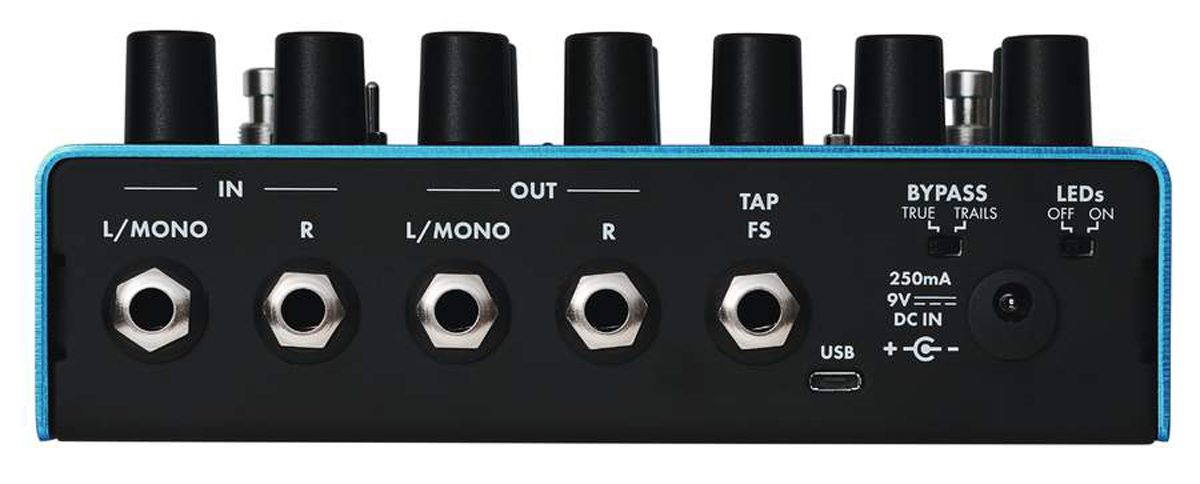Guitar World Verdict
A versatile, well thought-out offering that delivers a wide range of ambience, with some great-sounding algorithms.
Pros
- +
Simple operation.
- +
Two effects in one pedal.
- +
Flexible use of a secondary delay.
- +
Tap tempo with a range of subdivisions.
- +
Variable delay repeat quality.
- +
Optional LED-lit controls.
Cons
- -
We’d liked to have seen a specific spring emulation.
You can trust Guitar World
If you’re going to have delay and reverb on your pedalboard, both effects in the same pedal can be a practical way to go about things by saving on space, power outlets and audio cabling, as well as likely looking neater.
Fender’s take on that particular genre is the Reflecting Pool, with separately footswitchable delay and reverb that can be used independently or together – the delay feeding the reverb.
This good-looking stereo and mono pedal appears on the surface to be a combination of the Mirror Image Delay and the Marine Layer Reverb, but it’s much more than just that.
Modulation can be added via Rate and Depth knobs, whether that be subtle chorusing or more wayward pitch fluctuations
While those may have formed the building blocks, the features of each have been expanded for more versatility, and both offer nine variations on their effect instead of six for starters.
Sound
The delay side of the pedal is equipped with an easily operated tap tempo footswitch allied to seven selectable subdivisions. If you’re not using tap tempo, the Time knob selects the delay time from 10ms, where you can dial in a neat dry modulation through to a full one-second delay.
Standard Feedback and Level knobs respectively adjust the number of repeats and their volume against the dry sound through to fully wet, while modulation can be added via Rate and Depth knobs, whether that be subtle chorusing or more wayward pitch fluctuations.
The final knob in the delay section is Mix, which controls the feature that sets this particular delay apart from many others on the market. As with the Mirror Image’s fixed‑volume extra dotted eighth note, you can add in a secondary repeat
All the latest guitar news, interviews, lessons, reviews, deals and more, direct to your inbox!
related to the main repeat. Here, however, you get control over its volume, the relative levels of this secondary tap and the main repeat being set via this Mix knob, which has a 50:50 mix at its central position.
There’s plenty here to sculpt some tasty U2-style rhythmic echoes with three choices of how the two relate in timing to the quarter note: the second tap can be 50 per cent (eighth note), 66 per cent (quarter note triplet) or 75 per cent (dotted eighth note).
As for the actual sound of the delay, you have a choice of straight digital delay, a BBD analogue delay emulation or a tape echo emulation. Each has three variations of repeat quality: one standard, the others progressively degraded.
The Analog and Tape delays both reflect the tonal flavour of the originals very well, but that extra nuance of lower fidelity and altered EQ conferred by the Quality switch options greatly increases flexibility.
The Reverse reverb proved to be the sort of effect that you can dig into and release your inner freak
There are three selectable reverb types, Hall, Room and Special, each with three variations. The Hall and Room variations are small, medium and large versions of the chosen space, but select the Special type and it will offer a Shimmer reverb with high octaves, a Gated/Reverse reverb and a Modulated reverb.
Besides knobs for reverb Level, Decay (length of tail) and Damp (high-frequency roll-off ), an Extra knob controls low-frequency roll-off for the Hall and Room reverbs but adjusts the Shimmer reverb’s octave level, sets the Gated/Reverse reverb’s tail shape to determine whether you hear reverse, gated or just a typical small space, and controls the mod depth of the modulated reverb.
Verdict
While combining separate pedals could possibly be more focused for specific needs and give a wider range of options, this two-fer is a very balanced and practical pedal with enough variety in both of its sides to fulfil the needs of many players.
On the delay side, the three basic flavours of the last six decades are amply covered, while that second delay tap opens up many possibilities, and the reverb complements the delay well. Together, they could deliver all the ambience you’d need on a gig.
Specs
- PRICE: $299.99 / £259 / €259 street
- ORIGIN: USA
- TYPE: Reverb & delay pedal
- FEATURES: True or Trails bypass, 10ms to 1,000ms delay range, tap tempo, firmware updates via USB, LED markers on control knobs
- CONTROLS: Reverb Decay, Reverb Damp, Reverb Level, Reverb Extra, Reverb Type switch, Reverb Variation switch, Delay Time, Delay Feedback, Delay Mix, Delay Rate, Delay Depth, Delay Type switch, Delay Subdivision switch, Delay Quality switch, True/Trails bypass switch, LEDs on/off switch, Reverb footswitch, Tap footswitch, Delay footswitch
- EFFECTS TYPES: Hall Reverb, Room Reverb, Special Reverb, Digital Delay, Analog Delay, Tape Delay
- CONNECTIONS: Standard inputs (Left/Mono, Right), standard outputs (Left/Mono, Right), Tap footswitch, USB
- POWER: 9V DC adaptor (not supplied) 250mA
- DIMENSIONS: 170 (w) x 125 (d) x 63mm (h)
- CONTACT: Fender
Trevor Curwen has played guitar for several decades – he's also mimed it on the UK's Top of the Pops. Much of his working life, though, has been spent behind the mixing desk, during which time he has built up a solid collection of the guitars, amps and pedals needed to cover just about any studio session. He writes pedal reviews for Guitarist and has contributed to Total Guitar, MusicRadar and Future Music among others.




